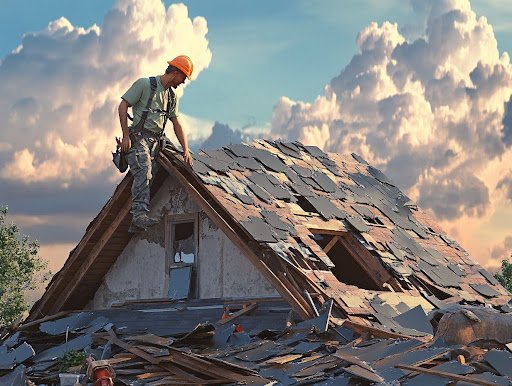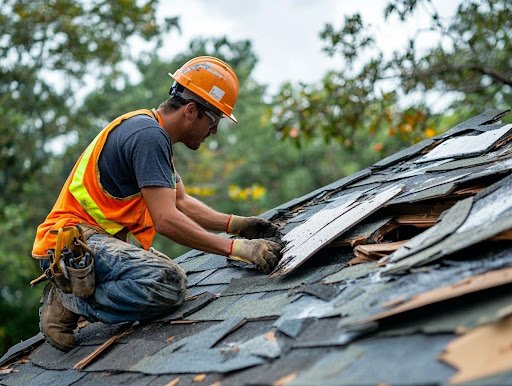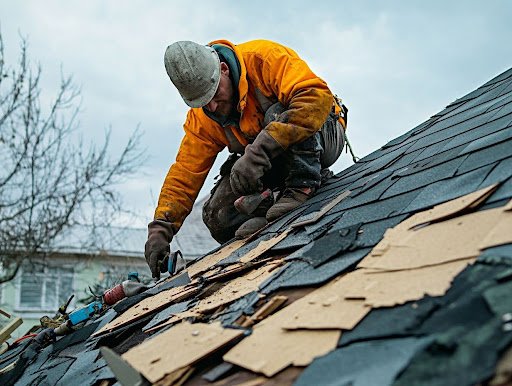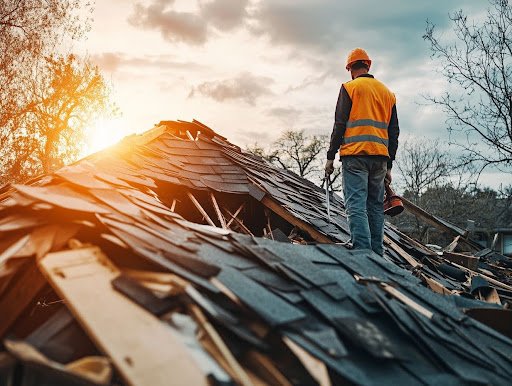Storm Damaged Roof Replacement
- Trusted Roofing Professionals Melbourne
- Free Quotes Available
- Contact Us Now
Storms can cause significant damage to a residence, particularly to the roof, which is the primary defence against environmental elements. If you have recently experienced storm damage, it is essential to understand the appropriate steps to take to protect your property and facilitate a smooth recovery process. This guide will detail the critical actions necessary to address roof damage, guide the selection of a reputable roofing company in Melbourne, and outline what to expect during the replacement process. Furthermore, we will offer recommendations for preventing future damage to help you proactively safeguard your home.
Key Takeaways:
- For insurance purposes, inspect and document the damage to your roof immediately after a storm.
- When choosing a roofing company in Melbourne, VIC, look for local, licensed, and insured companies with good reviews and references.
- The process of replacing a storm-damaged roof involves inspection, obtaining permits and materials, removing old materials, repairing/replacing the damaged structure, installing new materials, and final inspection.
What to Do After a Storm Damages Your Roof?
Following storm damage to the roof, including water damage and missing shingles, it is imperative to take prompt action to assess the situation and prevent further complications. This process involves conducting a thorough roof inspection to identify visible damage, such as missing tiles, debris accumulation, or indications of water damage. If not addressed in a timely manner, these can lead to more severe roofing issues and potential mould growth.
Furthermore, it is essential to consider the impact of the storm’s aftermath on the roof’s structural integrity and the potential for leaks or gutter blockages, which may necessitate the engagement of professional roofing services.
Adopting a comprehensive repair approach, including professional roofing evaluations, can mitigate long-term damage and facilitate a more efficient insurance claims process.

Inspect the Damage
Conducting a comprehensive roof inspection following a storm is essential for identifying any potential storm damage, including roof leaks, structural damage, and other roofing issues that may have developed.
Property owners must understand that even minor damage can escalate into significant problems over time. Therefore, it is crucial to prioritise a diligent and prompt assessment of their roofs. This inspection process systematically evaluates various components to ensure that hidden issues do not undermine the roof’s integrity.
- First, verify the condition of missing tiles, as their absence can expose the underlying layers and facilitate leaks.
- Next, examine the flashing around chimneys and vents for any signs of damage that could permit water ingress.
- Additionally, ensure that gutters are devoid of blockages, as accumulated debris can lead to water backup, resulting in increased strain and potential leaks.
Property owners can identify early signs of trouble by systematically inspecting these critical areas and taking proactive measures to protect their homes.
Document the Damage
Documenting the storm’s aftermath and the damage following a storm is a critical step in facilitating the smooth processing of insurance claims for roof repairs.
To effectively navigate this process, it is essential to capture every aspect of the destruction meticulously. Begin by taking clear and detailed photographs of all visible damage, focusing on areas such as the roof, gutters, and any interior impacts. These images serve as vital evidence to support your claims.
Additionally, making notes describing the extent of the damage can be invaluable; it is essential to record details such as the date, time, and specific circumstances surrounding the storm. Maintaining thorough records enhances the efficiency of the claims process and strengthens your position should any disputes arise.
The following checklist may be helpful:
- Take wide-angle photographs of the entire property
- Capture close-ups of significant damage
- Document any repairs attempted before the arrival of the insurance assessor
- Maintain a journal of events related to the damage and your recovery efforts
By adhering to these steps, you ensure that all necessary information is readily available, significantly improving your chances of a successful claim.
Contact Your Insurance Company
Once the storm damage to the roof has been documented, the subsequent crucial step is to contact the insurance company to initiate the claims process.
A comprehensive understanding of your policy coverage is essential during this phase, as it ensures awareness of the damages included and the procedures required for filing a claim. Many homeowners may feel overwhelmed at this stage; therefore, it is vital to communicate effectively with the insurance representative.
To facilitate this process, homeowners should:
- Prepare all necessary documentation, including damage photographs and repair estimates.
- Have policy information readily available to enhance the efficiency of the conversation.
- Ask clarifying questions regarding any terms or conditions that may be unclear.
Roofing contractors can provide invaluable support in navigating the claims process. They can furnish detailed reports on the damage, assist in estimating repair costs, and even liaise with the insurance company on the homeowner’s behalf.
By collaborating closely with a trusted contractor, homeowners can ensure that their claims are accurate and adequately reflect the true extent of the damage.
Choosing a Roofing Company in Melbourne, VIC
Selecting a qualified and reputable roofing company in Melbourne, VIC, is crucial for effectively repairing storm damage. This ensures that your roof is restored to its optimal condition and that any roofing issues are addressed promptly.
Given the plethora of options available, it is advisable to consider local companies that specialise in professional roofing services, possess a strong reputation, and are knowledgeable about the insurance claims process for homeowners in the Sunshine Coast area. This decision can substantially influence the quality of repairs and the durability of your roofing materials, especially in areas prone to cyclone damage.
Look for Local Companies
When selecting a roofing company, it is advisable to prioritise local roofing contractors like A. I Gutter & Roofing possess a comprehensive understanding of the specific challenges faced by homes in the Sunshine Coast area.
This emphasis on local expertise ensures that contractors are well-acquainted with the unique climate conditions and seasonal weather patterns, as well as local building codes and regulations that may impact the roofing project. Due to their proximity, local contractors are also positioned to provide timely inspections and repairs, allowing for rapid response to emergencies.
Engaging local contractors offers the advantage of fostering personal relationships, enhancing communication and building trust throughout the project.
Additional benefits of hiring local contractors include:
- Knowledge of local suppliers
- Awareness of neighbourhood architectural styles
- Established reputation within the community
Homeowners can make informed decisions by selecting local expertise while supporting the local economy.

Check for Licensing and Insurance
Before engaging the services of a roofing company, it is imperative to verify that they possess the appropriate licences and insurance coverage to protect themselves and the homeowner.
This due diligence safeguards against potential legal issues and ensures the work is performed to a high standard. Homeowners should seek documentation that indicates the contractor’s licensing status, including the type and scope of work they are authorised to undertake. Verifying insurance coverage is equally important; a reputable contractor will carry general and employer liability insurance.
Neglecting to verify this documentation can result in significant financial risks should an accident occur or if the work fails to meet industry standards.
Consider the following points:
- Confirm that the licence is valid and up to date.
- Review the contractor’s insurance policy limits.
- Request references and evaluate their past work.
Read Reviews and Ask for References
Reading customer reviews and requesting references from previous clients can provide valuable insights into the reliability and quality of roofing contractors.
Understanding this aspect is essential for Sunshine Coast homeowners who want to make informed decisions. Feedback not only highlights contractors’ strengths and weaknesses but also reflects their commitment to customer satisfaction, especially during storm repair projects. Prospective clients should focus on several key sources to identify credible reviews, including specialised home improvement websites, Google reviews, and social media platforms.
Tip: Look for patterns in ratings and comments. Additionally, it is advisable to request references directly from contractors like Stormguard Roofing during the consultation process, and it is essential to inquire about their experiences and outcomes.
This comprehensive approach enables homeowners to assess potential contractors’ trustworthiness and service quality, such as A. I Gutter & Roofing, thereby fostering confidence in their decision-making process.
The Process of Storm-Damaged Roof Replacement
Replacing a storm-damaged roof involves several critical steps that ensure a professional and comprehensive approach to repair and restoration.
Initially, a thorough roof inspection is carried out to evaluate the extent of the structural damage and identify the necessary roofing materials required for the repair, including checking for flashing damage. Based on this assessment, homeowners can collaborate with professional roofing contractors to commence storm repairs that restore the roof’s functionality and aesthetic appeal, thereby ensuring long-term durability against future weather events.
Inspection and Assessment of the Damage
The initial step in replacing a storm-damaged roof involves a comprehensive inspection and assessment of the damage to determine the extent of repairs required.
This detailed examination is essential, as it enables roofing contractors to identify the visible damage and any potential underlying issues that may not be immediately observable. Inspectors typically search for indicators such as missing tiles, leaks, structural integrity, and signs of water damage or heavy rain effects within the home. These factors are crucial, as they directly influence the overall repair strategy and ensure that the project addresses aesthetic and functional considerations.
Once all necessary information has been collected, contractors discuss their findings with homeowners, detailing the conditions observed and outlining the required materials along with an estimated timeline for repairs and replacements.
A thorough inspection is the foundation for a successful roofing project, providing clarity on the necessary steps to be taken.
Obtaining Necessary Permits and Materials
Once the damage has been thoroughly assessed, the subsequent step involves obtaining any necessary permits and gathering the required roofing materials for the replacement.
Securing these permits is essential, as it ensures compliance with local building regulations and protects the homeowner from potential fines and legal complications that could arise from unauthorised work, particularly in flood restoration projects.
The roofing materials available vary significantly, encompassing asphalt shingles, metal roofing, and tiles. Each material presents distinct advantages regarding durability, cost, and aesthetic appeal:
- Asphalt shingles – Popular for their affordability and ease of installation.
- Metal roofing – Recognised for its longevity and energy efficiency.
- Tiles – Provide an elegant appearance, but may be more expensive and heavier.
Engaging professional roofing contractors can streamline this process, ensuring that all necessary documentation is filed correctly and that the most suitable materials are selected to meet the homeowner’s specific needs. Their expertise is instrumental in facilitating a smooth and compliant roofing replacement.

Removal of Old Roofing Materials
Removing old roofing materials is a crucial step in the storm repair process, as it establishes a stable and durable foundation for installing new roofing materials.
Executing this removal properly requires the use of appropriate tools and techniques and adherence to essential safety precautions, similar to debris removal during maintenance tasks. Before commencing such a project, it is imperative to utilise suitable safety gear, including gloves, goggles, and a hard hat, to protect against falling debris and sharp edges.
Moreover, understanding how to access the roof and navigate its surface safely is vital in significantly reducing the risk of accidents.
Following the completion of the old roofing removal, it is essential to dispose of the damaged materials responsibly. This involves contacting local waste management services or recycling centres to ensure proper disposal. Such actions safeguard the environment and ensure compliance with local regulations regarding hazardous waste.
Adhering to these protocols guarantees that the new roofing installation commences on a solid and secure foundation.
Repairing or Replacing Damaged Roof Structure
Once the old roofing materials have been removed, the subsequent phase involves assessing and addressing any structural damage to ensure the integrity of the new roof.
During this critical stage, evaluating the condition of the roof’s underlying components, such as boarding and rafters, is imperative. Any indications of rot, water damage, or insect infestation, especially following hail, must be addressed promptly to avert future complications.
- Repairing damaged boarding is essential for maintaining proper insulation and ventilation.
- Replacing compromised rafters guarantees a solid foundation for the new roofing system.
Professional roofing contractors typically conduct a comprehensive inspection, identifying visible damage and potential underlying issues that could affect the new roof’s longevity. By utilising advanced techniques and equipment, these specialists develop a strategic plan to manage repairs effectively, thereby safeguarding the homeowner’s investment and preserving the overall quality of the roofing project.
Installation of New Roofing Materials
The installation of new roofing materials may commence upon completion of the structural repairs. This step is essential for ensuring the roof’s durability against future storms.
Homeowners have a range of roofing materials from which to choose, each presenting distinct advantages. The available options include:
- Asphalt Shingles: Recognised for their affordability and ease of installation.
- Metal Roofing: Known for its exceptional durability, often lasting for decades, it is resistant to extreme weather conditions.
- Tile and Slate: Offer remarkable longevity and aesthetic appeal, though they may be heavier and more costly.
- Wood Shingles: Provide a rustic charm but necessitate more maintenance to prevent decay.
The installation process generally entails a comprehensive assessment, removing existing materials, if required, and meticulously placing the new roofing systems to ensure proper sealing and protection.
Engaging professional roofing contractors is critical. They bring valuable expertise and ensure quality assurance throughout the project, thereby minimising potential future issues.
Clean-up and Final Inspection
The final step in replacing a storm-damaged roof involves a thorough clean-up and a comprehensive final inspection to ensure that all work has been completed to the highest standards.
This critical phase not only underscores the importance of aesthetics but also guarantees the safety and longevity of the roofing system. A meticulous clean-up entails removing debris, reviewing any remaining materials, and confirming that the property is left in immaculate condition.
During the final inspection, professionals evaluate the installation, checking for potential leaks or misalignments that could compromise the roof’s integrity. Roofing experts like Sky High Roofing are essential in this process, conducting detailed assessments and addressing any identified issues before they escalate, thereby protecting property owners’ investment.
Their unwavering commitment to quality is evident in every completed roof replacement, providing homeowners with peace of mind that their roofs can withstand future storms.
How Long Does a Storm-Damaged Roof Replacement Take?
The duration of a storm-damaged roof replacement can vary significantly based on several factors, including the extent of the damage and the type of roofing materials selected.
Additional critical elements, such as the availability and expertise of the roofing contractor, also play a pivotal role in determining the overall timeline. Weather conditions can further influence scheduling, particularly if subsequent storms are anticipated.
For instance, repairs for minor damage may take just a few days, whereas a complete roof replacement may require the following timeframes:
- 2 to 4 weeks for asphalt shingles
- 3 to 6 weeks for metal roofing
- 4 to 8 weeks for tiled roofs
These durations ensure all components are correctly installed and inspected, whether for the Sunshine Coast or elsewhere. Furthermore, permit requirements and materials sourcing can introduce additional delays, making it essential for homeowners to plan accordingly.

How Much Does a Storm-Damaged Roof Replacement Cost?
The cost of replacing a storm-damaged roof can vary significantly based on several factors, including the extent of the damage, the selected roofing materials, and the potential use of insurance claims from various insurance companies.
In addition to these primary considerations, various other factors can influence roof replacement costs, especially when considering DIY repairs versus professional services.
For example, geographical location plays a critical role; different regions may exhibit varying labour rates and accessibility to materials. Homeowners must carefully evaluate the quality of the chosen materials, as premium options typically incur higher expenses.
Furthermore, the complexity of the roof design can also affect labour costs, as intricate patterns necessitate more skilled workmanship and time.
- Material Costs: The type of roofing material—such as asphalt shingles, metal, or tiles—can drastically alter pricing.
- Labour Costs: Specialised installations may require skilled labour, contributing to overall expenses.
- Insurance Coverage: A comprehensive understanding of an insurance policy’s specifics can significantly impact out-of-pocket costs.
Ultimately, obtaining multiple estimates and consulting with industry specialists such as Stormguard Roofing or A. I Gutter & Roofing can assist homeowners in navigating these variables, facilitating well-considered choices when addressing roof repairs.
Preventing Future Storm Damage to Your Roof
To prevent future storm damage to the roof, proactive roof maintenance and the selection of durable roofing materials capable of withstanding severe weather conditions are essential.
Regular Roof Maintenance
Regular roof maintenance is crucial for identifying potential issues before they develop into significant repair needs due to storms, and companies like Sky High Roofing specialise in this service.
Conducting routine inspections at least twice a year can significantly enhance the overall integrity of a roofing system. These inspections should focus on assessing for loose tiles, damaged flashings, and any signs of moss or algae growth.
Seasonal gutter cleaning is essential to ensure that water can flow freely, thereby reducing the risk of pooling that could result in leaks over time. Additionally, re-sealing joints every three to five years is advisable to prevent water ingress, which could lead to structural damage.
By adhering to these maintenance guidelines, property owners protect their investment and extend the lifespan of their roofs, ultimately ensuring long-term protection against the elements.
Choosing Durable Roofing Materials
Selecting durable roofing materials is a critical factor in mitigating storm damage and ensuring the longevity of a roof.
In considering this essential aspect, homeowners should explore various roofing materials that provide superior protection against the elements. Options such as metal, asphalt tiles, slate, and synthetic materials are popular choices, each offering unique advantages.
For example, metal roofs are renowned for their remarkable longevity and ability to withstand high winds, whereas asphalt tiles are cost-effective and exhibit improved resistance to hail damage. Slate roofs, known for their substantial weight and durability, are often preferred in storm-prone regions.
- Metal Roofing: Highly resistant to wind and hail.
- Asphalt Tiles: Affordable and versatile, featuring enhanced durability.
- Slate Roofing: Provides exceptional protection due to its weight.
- Synthetic Materials: Lightweight yet resilient options.
Consulting with professional roofing contractors can greatly assist homeowners in navigating these choices. Experts can evaluate specific requirements, recommend materials suited to the local climate, and ensure proper installation practices, ultimately contributing to a more resilient structure.
Installing Proper Drainage Systems
Installing appropriate drainage systems is essential for preventing water damage and gutter blockages, which can lead to significant roofing issues during storms.
Effective drainage systems not only protect structures from water’s damaging effects but also contribute to the building’s overall longevity. Inadequate gutter systems can become overwhelmed, leading to premature deterioration of roofing materials and potential leaks within the property.
Regular maintenance is equally important; by routinely clearing debris and conducting inspections for damage, homeowners can ensure that their drainage systems operate effectively. This proactive strategy helps mitigate repair costs and fosters a healthier environment by reducing the risk of mould growth associated with stagnant water.
Key benefits of proper drainage systems include:
- Prevention of structural damage
- Enhancement of property value
- Minimisation of health risks
Conclusion: Trust a Professional for Your Storm-Damaged Roof Replacement in Melbourne, VIC and Sunshine Coast
Entrusting the replacement of a storm-damaged roof to professional roofing contractors in Melbourne, VIC, such as Brisbane Bayside Roof Repairs, is essential for ensuring high-quality repairs and a comprehensive understanding of the insurance claims process.
By engaging experts in the field, homeowners can achieve superior workmanship while effectively navigating the often-complex process of claiming insurance benefits. These contractors possess the requisite skills and experience to accurately assess storm damage and implement repairs that comply with safety regulations and meet aesthetic standards.
- Expert Assessment: Comprehensive evaluations of roof conditions following a storm.
- Quality Materials: Access to durable and suitable roofing materials.
- Insurance Knowledge: Assistance with paperwork and claims processes.
- Safety Regulations: Adherence to local building codes.
Professional assistance can save time, alleviate stress, and result in durable solutions that safeguard the home for years.
Frequently Asked Questions
What is storm-damaged roof replacement?
Storm-damaged roof replacement is the process of replacing a roof that has been damaged by a severe storm. This can include damage from strong winds, hail, or heavy rainfall.
How do I know if my roof needs to be replaced? Consult with roofing professionals!
If a storm has damaged your roof, it is vital to have a professional inspection to determine the extent of the damage. Signs that your roof may need to be replaced include missing or damaged shingles, leaks, and water stains on the ceiling.
Will my insurance cover the cost of storm-damaged roof replacement?
Most homeowners’ insurance policies will cover the cost of storm-damaged roof replacement. However, checking with your insurance provider to understand what is covered and any applicable deductibles is essential.
Can I choose the type of roofing material for my replacement?
Yes, you can choose the type of roofing material for your replacement. Our team at Melbourne Roof Services offers a variety of options, including asphalt shingles, metal roofing, and tile roofing, to fit your budget and preferences.
How long does it take to replace a storm-damaged roof?
The timeline for replacing storm-damaged roofs can vary depending on the extent of the damage and the type of roofing material chosen. Our team strives to complete the replacement efficiently while ensuring high-quality work.
Do I need to be home during the storm-damaged roof replacement process?
No, you do not need to be home during the replacement process. Our team will work with you to schedule a convenient time for the replacement and keep you updated on the progress.
